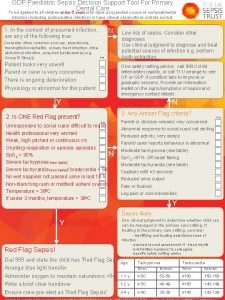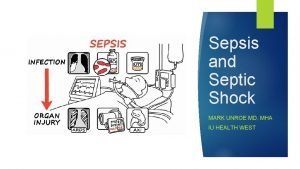GDP Paediatric Sepsis Decision Support Tool For Primary

- Slides: 1

GDP Paediatric Sepsis Decision Support Tool For Primary Dental Care To be applied to all children under 5 years who have a suspected source of orofacial/dental infection (including postoperative infection) or have clinical observations outside normal limits 1. In the context of presumed infection, are any of the following true: N (consider other common sources: pneumonia, meningitis/encephalitis, urinary tract infection, intraabdominal infection, acquired bacteraemia (e. g. Tick Group B Strep)) Patient looks very unwell Parent or carer is very concerned Low risk of sepsis. Consider other diagnoses. Use clinical judgment to diagnose and treat potential sources of infection e. g. perform tooth extraction. Give safety netting advice: call 999 if child deteriorates rapidly, or call 111/ arrange to see GP or GDP if condition fails to improve or gradually worsens. Provide an information leaflet on the signs/symptoms of sepsis and emergency contact details. There is ongoing deterioration Physiology is abnormal for this patient Y N 3. Any Amber Flag criteria? 2. Is ONE Red Flag present? Tick Unresponsive to social cues/ difficult to rouse Health professional very worried Weak, high pitched or continuous cry Grunting respiration or apnoeic episodes N Sp. O 2 < 90% Severe tachypnoea (see table) Severe tachycardia (see table)/ bradycardia < 60 No wet nappies/ not passed urine in last 18 h Non-blanching rash or mottled/ ashen/ cyanotic Temperature < 360 C If under 3 months, temperature > 380 C Tick Parent or clinician remains very concerned Abnormal response to social cues/ not smiling Reduced activity, very sleepy Parent/ carer reports behaviour is abnormal Moderate tachypnoea (see table) Sp. O 2 <91% OR nasal flaring Moderate tachycardia (see table) Capillary refill ≥ 3 seconds Reduced urine output Pale or flushed Leg pain or cold extremities Y Sepsis likely Y Red Flag Sepsis! Use clinical judgment to determine whether child can be managed in the primary care setting. If treating in the primary care setting, consider: -identifying and treating potential sources of infection -planned second assessment +/- blood results -brief written handover to colleagues -specific safety netting advice If immunity impaired refer for urgent hospital assessment Dial 999 and state the child has ‘Red Flag Sepsis’ Tachypnoea Tachycardia Severe Moderate Administer oxygen to maintain saturations >94%< 1 y ≥ 60 50 -59 ≥ 160 150 -159 Write a brief clear handover 1 -2 y ≥ 50 40 -49 ≥ 150 140 -149 Ensure crew pre-alert as ‘Red Flag Sepsis’ 3 -4 y ≥ 40 35 -39 ≥ 140 130 -139 Arrange blue light transfer Age

